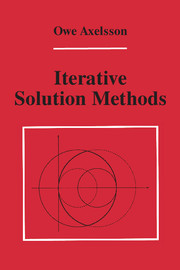Book contents
- Frontmatter
- Contents
- Preface
- Acknowledgments
- 1 Direct Solution Methods
- 2 Theory of Matrix Eigenvalues
- 3 Positive Definite Matrices, Schur Complements, and Generalized Eigenvalue Problems
- 4 Reducible and Irreducible Matrices and the Perron-Frobenius Theory for Nonnegative Matrices
- 5 Basic Iterative Methods and Their Rates of Convergence
- 6 M-Matrices, Convergent Splittings, and the SOR Method
- 7 Incomplete Factorization Preconditioning Methods
- 8 Approximate Matrix Inverses and Corresponding Preconditioning Methods
- 9 Block Diagonal and Schur Complement Preconditionings
- 10 Estimates of Eigenvalues and Condition Numbers for Preconditioned Matrices
- 11 Conjugate Gradient and Lanczos-Type Methods
- 12 Generalized Conjugate Gradient Methods
- 13 The Rate of Convergence of the Conjugate Gradient Method
- Appendices
- Index
4 - Reducible and Irreducible Matrices and the Perron-Frobenius Theory for Nonnegative Matrices
Published online by Cambridge University Press: 05 August 2012
- Frontmatter
- Contents
- Preface
- Acknowledgments
- 1 Direct Solution Methods
- 2 Theory of Matrix Eigenvalues
- 3 Positive Definite Matrices, Schur Complements, and Generalized Eigenvalue Problems
- 4 Reducible and Irreducible Matrices and the Perron-Frobenius Theory for Nonnegative Matrices
- 5 Basic Iterative Methods and Their Rates of Convergence
- 6 M-Matrices, Convergent Splittings, and the SOR Method
- 7 Incomplete Factorization Preconditioning Methods
- 8 Approximate Matrix Inverses and Corresponding Preconditioning Methods
- 9 Block Diagonal and Schur Complement Preconditionings
- 10 Estimates of Eigenvalues and Condition Numbers for Preconditioned Matrices
- 11 Conjugate Gradient and Lanczos-Type Methods
- 12 Generalized Conjugate Gradient Methods
- 13 The Rate of Convergence of the Conjugate Gradient Method
- Appendices
- Index
Summary
Various topics of matrix theory, in particular, those related to nonnegative matrices (matrices with nonnegative entries) are considered in this chapter. We introduce the concepts of reducible and irreducible matrices and matrix graph theory (the concepts of directed and strongly connected graphs), and show the equivalence between irreducibility of a matrix and the connectivity of its directed graph. This enables us, among other things, to strengthen the Gershgorin theorem for estimating the location of eigenvalues of irreducible matrices. In order to determine if a symmetric matrix is positive definite, we need information regarding the signs of its eigenvalues. Also, in order to determine the rate of convergence of certain iterative methods to solve linear systems of algebraic equations, we need to know—as we shall see in later chapters—some information regarding the location of the eigenvalues of the iteration matrix.
The Perron-Frobenius theorem, showing that the spectral radius ρ(A) is an eigenvalue corresponding to a positive eigenvector, if A is nonnegative and irreducible, is presented. It will be seen in some of the following chapters that the concept of numerical radius can give sharper estimates of the norm of the powers of matrices, for instance, than the spectral radius can. Some results relating the numerical radius with the norm of the matrix and with the spectral radius of the symmetric part of nonnegative matrices are presented.
- Type
- Chapter
- Information
- Iterative Solution Methods , pp. 122 - 157Publisher: Cambridge University PressPrint publication year: 1994



